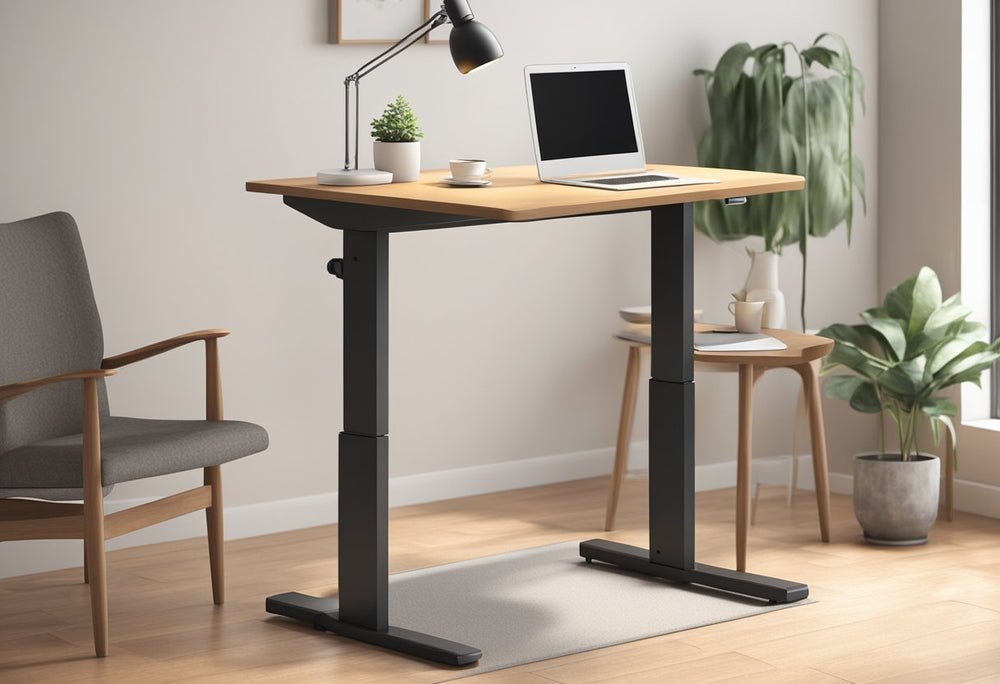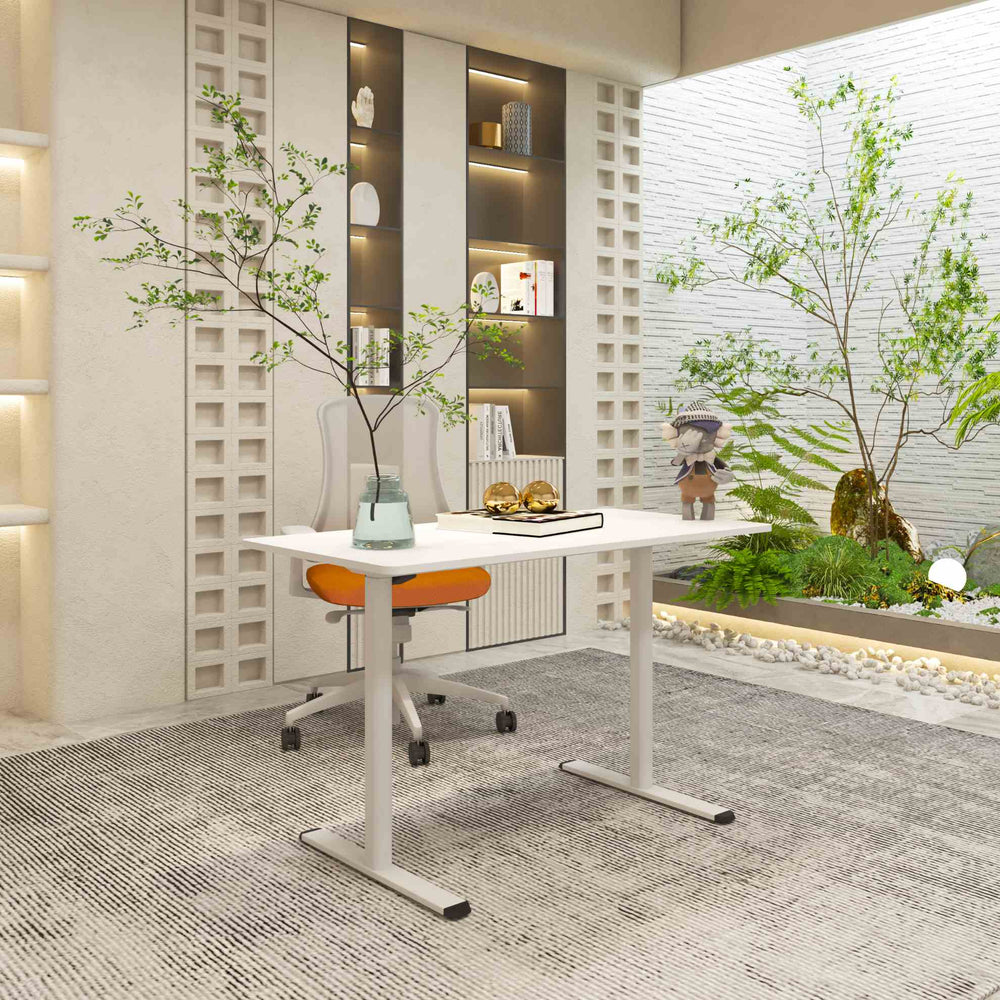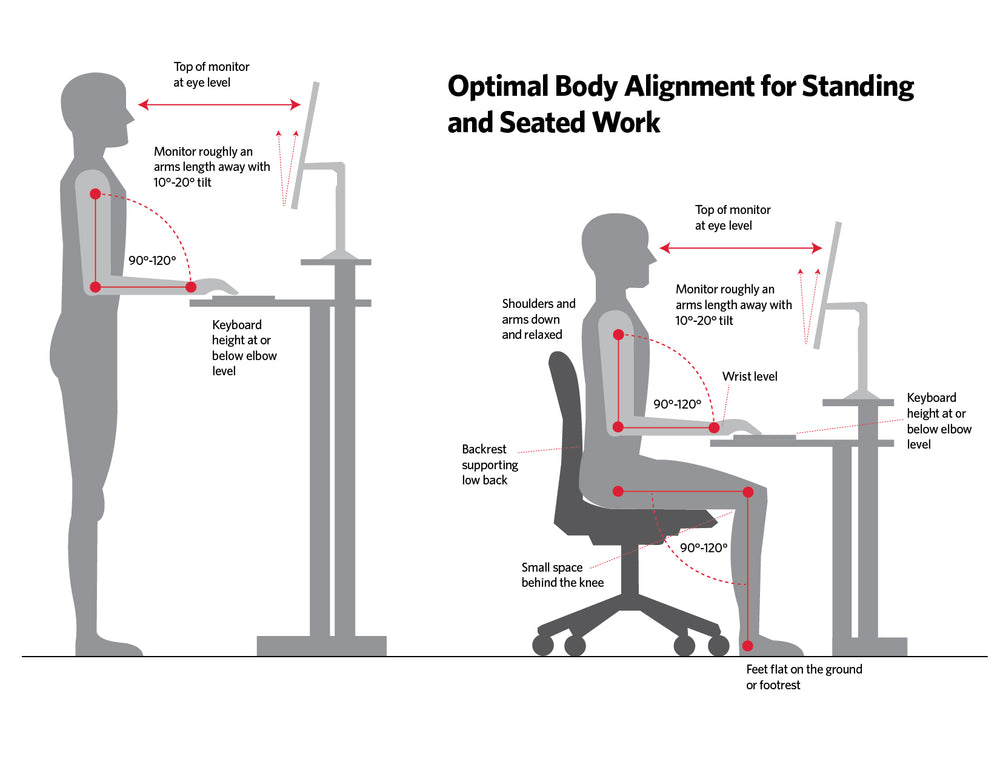Date: July 29, 2022
Knowing the exact measurements of your existing desk is crucial to knowing what standing desk is right for you. This seems obvious right? Well, there are a lot of standing desks that take up a much larger footprint than you would imagine. Consider the stand up desk below: 
(Dimensions Listed: 36in W x 22in D x 6.5in to 16in H)
Those dimensions seem pretty straightforward, right? Not quite. What isn’t mentioned and what is hard to see in the picture above is that this standing desk actually comes toward you almost a full foot as it elevates to a standing position, making the total depth about 32-34in at the highest height.
Why does it Matter if a Standing Desk Doesn't Rise Straight Up?
Well, if you or your co-workers are purchasing a standing desk for a standard office / cubicle with limited amount of space, then there is only so much room to push your chair back out of the way when you rise from sit to stand up.
Some people prefer desks that rise up toward you and down and away from you because it gets them away from their desktop surface and in some cases it requires less bending forward to lift and lower the standing desk.
Another downside to these desks that don't rise straight up is they may be less sturdy and more likely to tip over. Most of these desk risers have weighted legs to counterbalance the weight so they don't topple over, but earlier desk risers from Varidesk and other companies came out almost a full foot and were likely to tip over.
Does the keyboard tray touch the desk surface?

When it is at its lowest position, the keyboard tray should rest right on the desk surface. The reason being, imagine working at your desk for hours and having to lift your wrist slightly throughout the day because the keyboard tray doesn't touch down on the desk.
Over time, this can develop into carpal tunnel syndrome, which causes pain, numbness, and tingling in the hand and arm. The condition occurs when one of the major nerves to your hand — the median nerve — is squeezed or compressed as it travels through your wrist.
So how do you know if the keyboard tray doesn't rest on the desk surface? The seller or manufacturer of the product should be able to answer this very simple question for you:
“Does the keyboard tray on your standing desk touch the desk surface underneath it when it is at its lowest height?”
If they can’t answer the question or if the answer is “No” then run away as fast as you can and find another desk riser!
Does the standing desk have a retractable keyboard tray (Slides in and out)?
An ergonomic, adjustable height sit to stand desk ideally should have a keyboard tray that slides in and out. Many people prefer this type of desk riser.
If the keyboard tray is not retractable, then at the very least there should be enough distance between the front edge of the desktop surface and the front edge of the keyboard tray so that your face isn’t right in front of your monitor.
A sliding keyboard tray will allow you to sit or stand at a far enough distance away from your monitor to avoid straining your eyes.
Our Desk Riser Classic, Desk Riser Pro, Desk Riser Grande, and Desk Riser Extra Grande all feature sliding keyboard trays. Below is the Desk Riser Classic.

Does the Standing Desk Rise Straight Up and Down
The angle at which the standing desk rises is important for a variety of reasons. First, as was mentioned above, if you have a smaller or even standard workspace, a desk that rises up and toward you any more than a few inches could make your workspace uncomfortable.
Second, as experts ourselves on standing desktop converters after having tested over 50 different models of stand up desks before designing our own models, the stand up desks that come too far forward have a higher tendency to become very unstable when elevated and may even tip over.
Imagine standing at your desk and leaning on the top work surface for a break and then having your entire setup come crashing down to the floor.
During our testing we have had several standing desks tip over toward us and had our monitors crash down on the ground when we laid our elbow on it for a break. Take a look at this one for example, from Varidesk:

Any desk that comes up and out toward you more than 6 inches like the one shown above are at much greater risk of tipping over.
Think about this factor if you’re ordering your standing desks for your corporate wellness program. Not everyone’s office space works for these types of desks and some people may be more prone than others to lean on their standing desks throughout the day.
While there are plenty of nice desks that rise up and outward, the downside to this feature is something to consider if it comes out too far.
Many of the newer models have weighted legs to counter this problem and they don't come out as far as they used to (Varidesk used to carry a desk riser that came out about 12 inches forward at it's tallest height).
What Size is the Standing Desk Desktop?
Everyone’s work space needs are different. Some people might only have enough room for a small standing desk. Some people might like the large standing desks.
Whatever your needs are, know the desktop work surface of dimensions of the standing desk you are considering. Measure them out on your desk and visualize what it will look like with monitors on top of them, a notepad, a pen, sticky notes, or whatever accessories you would like to have.
Grab a ruler and measure it out. Ask yourself these questions:
- How wide are your two monitors if you’re using a dual monitor setup?
- How deep is it at the point where you would put a notepad?
- Do you have overhead cabinets that might get in the way?
How Tall is the Standing Desk?
If you are taller than 6 feet (182cm) then its likely you will need a standing desk for a tall person. These desk risers are perfect for tall people because they rise up higher than standard desk risers.
Standing desk height is one of the key features to look for when shopping for an adjustable height desk. Some standing desk converters (desks that sit on top of your existing office desk and adjust up and down) only rise up to 16 inches high, for example. If you are taller than 6 feet then you will want to find a sit stand desk that rises higher than 16.5 inches.
Lucky for you, we have a full line of standing desks for tall people. Many of these adjustable height standing desks fit people up to 6 feet, 6 inches tall (78 inches | 198cm | 1.98m). We also carry a line of Standing Desks for Average Height People and a line of Kids Standing Desks.
In general, if you're close to 6 feet, we would recommend purchasing a tall standing desk mainly because if you want to add any standing desk accessories like a Balance Board for Standing Desks then it will add to your overall height when you're using it and you will find you are too tall for your desk riser.
Summary - Most Important Standing Desk Features
Ideally, you will want to find a desk that rises straight up/down or slightly toward you as it rises up. Make sure that it doesn't come too far forward because those standing desktop converters are at a very high risk of tipping over.
If you have a larger space then try to find one that is at least 30” wide, that has a retractable keyboard tray, and that is compatible with monitor arms if you use them.
With those features in mind, feel free to shop our list of manual standing desks. We also have electric standing desks if you have a bad back or have difficulty lifting heavier weights. We also recently launched a great tool that finds the perfect standing desk for you, called the DeskFinder. Click here to use it!








